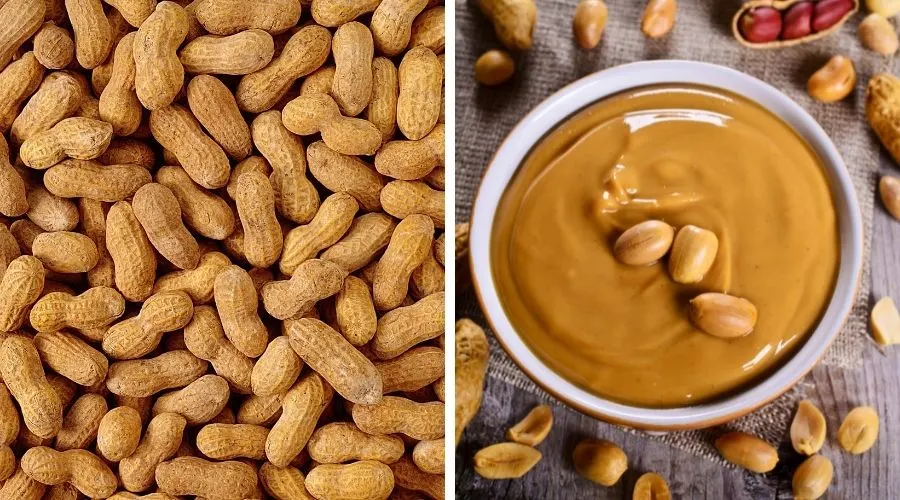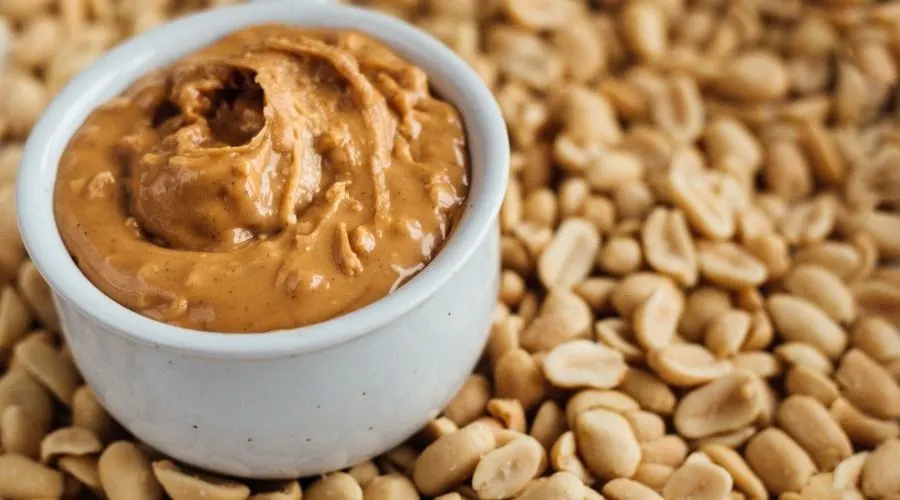You may not be surprised to learn that peanut butter and peanuts both have the same key ingredients – peanuts, but is there much difference when it comes to nutrition?
If peanuts and peanut butter are your snacks of choice and you’re reading this article, you’re probably wondering which is the best choice for your diet.
The main differences between peanuts and peanut butter are that peanuts are slightly lower in calories per weight than peanut butter and are lower in carbs, sugars, and fat. In contrast, peanut butter contains higher levels of micronutrients.
Read on to learn more about the differences between peanuts and peanut butter, including a complete nutrition and flavor comparison.
Also in This Article
In a hurry, or looking for something specific? Use the links below to jump to the relevant section:
- Ingredients Comparison
- Peanuts Vs. Peanut Butter Nutritional Comparison, including:
- Carbohydrates
- Fats
- Protein
- Sodium
- Vitamins & Minerals
- Flavor & Texture Comparison
- Summary

Ingredients Comparision
Firstly, let’s take a look at the difference between the ingredients of peanuts themselves and peanut butter.
It may seem obvious that the main ingredient of peanuts is the nut itself, but they’re sold in various forms, including dry roasted, salted, and honey roasted.
For the comparison in this article, I’m comparing peanuts with no added ingredients, but they can vary quite a bit depending on the brand and flavor.
For example, dry roasted peanuts generally contain added salt, sugar, and flavors such as garlic and onion powder.
In contrast, the typical ingredients of peanut butter are roasted peanuts, sugar, vegetable oil, salt, and preservatives. You can also get some brands that are lower in salt or don’t have any added sugars.
| Peanut Ingredients | Typical Peanut Butter Ingredients |
| Peanuts | Roasted Peanuts Sugar, Molasses, Fully Hydrogenated Vegetable Oils (rapeseed & Soybean), Mono & Diglycerides, Salt. |
Peanuts Vs. Peanut Butter Nutritional Comparison
Moving on to the nutritional comparison and keeping things fair and accurate, the data I’m using is per weight, which is an ounce (28g) serving or 100g.
The products I’m comparing are regular raw peanuts with no added ingredients such as salt or sugar against a generic store-bought peanut butter (as per official USDA data, see source links at the bottom of this page).
Calorie Comparison
When comparing the calorie content between regular peanuts and peanut butter, the two are pretty similar, with regular peanuts containing 8kcal fewer per ounce than peanut butter.
It’s important to note that peanuts can contain more calories than peanut butter if they’re coated in sugar or if you’re comparing them to lower fat or natural nut butter that doesn’t have any added sugar.
| Peanut Type | Calories Per 100g | Calories Per 1oz/28g Serving |
| Peanuts (raw) | 567kcal | 161kcal |
| Peanut Butter | 597kcal | 169kcal |
Carbohydrate Comparison
If you’re tracking the number of carbs you’re consuming, then per ounce, raw peanuts with no added sugar contain fewer carbs than peanut butter per serving.
Peanuts are also lower in sugars because peanut butter usually contains added sugar, although no sugar alternatives are available if you shop around.
Natural peanuts also contain 1g more dietary fiber than peanut butter per serving.
| Nutrition Type | Peanuts (raw) – Per 1oz/28g Serving | Peanut Butter – Per 1oz/28g Serving |
| Carbohydrates | 4.6g | 6.3g |
| of Which are Sugars | 1.4g | 3g |
| Dietary Fiber | 2.4g | 1.4g |
Fat Comparison
Peanuts are high in natural fats, and in most cases, additional fat is added to peanut butter in the form of vegetable oil. The majority of the fat in peanuts and peanut butter is monounsaturated and polyunsaturated, which are considered healthy fats.
Peanut butter is generally higher in fat than standard peanuts, but if you’re looking to reduce your fat intake, it’s a good idea to check the pack because some kinds of peanuts have added oil too.
Peanuts and peanut butter contain some saturated fat, with peanut butter containing around a gram more per ounce (28g). In most cases, neither peanuts nor peanut butter contains any trans fats or cholesterol, but this can vary between brands, so check the pack if you’re unsure.
| Nutrition Type | Peanuts (raw) – Per 1oz/28g Serving | Peanut Butter – Per 1oz/28g Serving |
| Fat | 13.9g | 14.5g |
| of Which is Saturated Fat | 1.8g | 2.9g |
| Trans Fat | 0g | 0g |
| Monounsaturated Fat | 6.9g | 7.2g |
| Polyunsaturated Fat | 4.4g | 3.5g |
| Cholesterol | 0mg | 0mg |
Protein Comparison
Most nuts are a great source of protein, and in the case of peanuts, they contain over 7g per ounce (28g) serving.
Peanut butter isn’t as high in protein as the nuts themselves and contains 5g less protein than a serving of peanuts of the same weight.
If you’re a peanut butter fan and looking to increase your protein intake, you can buy protein-enriched peanut butter in larger grocery stores.
| Nutrition Type | Peanuts (raw) – Per 1oz/28g Serving | Peanut Butter – Per 1oz/28g Serving |
| Protein | 7.31g | 2.1g |
Sodium/Salt Comparison
Raw peanuts are naturally low in sodium but salted, and dry roasted peanuts can be much higher in sodium if added to the ingredients.
Most kinds of peanut butter contain added salt, and in our comparison, a serving contains 116mg more sodium than raw peanuts.
For information, the recommended salt intake per day is less than 2,300mg per day (as confirmed by Healthline)
| Nutrition Type | Peanuts (raw) – Per 1oz/28g Serving | Peanut Butter – Per 1oz/28g Serving |
| Sodium/Salt | 5.1mg | 121.4mg |
Vitamins & Minerals Comparison
Peanuts and peanut butter both contain a range of vitamins and minerals. Still, when comparing the data between the two kinds, peanut butter has higher amounts of more micronutrients than peanuts.
Peanut butter is particularly rich in potassium, vitamin E, niacin (vitamin B3), and magnesium.
The table below shows the data for the number of vitamins and minerals found in 100g of peanuts and peanut butter so that you can see the difference between the two:
| Vitamin/Mineral Type | Amount Per 100g of Peanuts | Amount Per 100g Serving of Peanut Butter |
| Calcium | 26.1mg | 49mg |
| Iron | 1.3mg | 1.73mg |
| Phosphorus | 107mg | 107mg |
| Potassium | 200mg | 564mg |
| Magnesium | 47.6mg | 169mg |
| Thiamin | 0.181mg | 0.138mg |
| Riboflavin | 0.038mg | 0.191mg |
| Vitamin B6 | 0.099mg | 0.44mg |
| Vitamin E | 2.36mg | 9.11mg |
| Niacin | 3.43mg | 13.3mg |
| Copper | 0.323mg | 0.42mg |
| Manganese | 0.547mg | No data |
| Selenium | 2.04µg | 4.1µg |
| Zinc | 0.927mg | 2.54mg |
If you’d like more information about how much of each vitamin and mineral you should be consuming on a daily basis, take a look at this article over at Medical News Today.

Flavor and Texture Comparison
Regular peanuts have their own unique flavor and are often enhanced with other flavors, including salt, sugar, honey coatings, and dry-roasted coatings, which contain various savory flavorings.
Peanuts are generally sold roasted because this enhances the flavor and texture of the nut. Raw peanuts are a bit bland and they have a softer texture in contrast to a roasted peanut which has a crunchier texture.
In contrast, peanut butter has a creamy texture and a sweeter flavor than regular peanuts while retaining a savory element. Crunchy peanut butter is also available for those who like a crunch, where chopped peanuts are added to creamy peanut butter.
We’d really like to find out which is the public favorite between peanuts and peanut butter and would appreciate it if you could help us out by telling us which you like best. Once you vote, the winner so far will be revealed (see our privacy policy for more information on how we use voting information).
Summary
We’ve now compared all categories, so here’s an overview of all the main differences between peanuts and peanut butter:
- Weight-for-weight peanuts are slightly lower in calories than regular peanut butter (providing they’ve not been coated in high-calorie sugary coatings).
- Regular peanuts are lower in carbs and sugars than most kinds of peanut butter although lower-carb peanut butter is available which doesn’t contain any added sugar.
- Peanuts and peanut butter are high in fat, most of which are good fats, but penut butter is a little higher in fat because most brands contain added vegetable oils.
- Peanuts are higher in protein than most kinds of peanut butter, but you can buy peanut butter with added protein.
- Peanut butter is higher in certain vitamins and minerals than regular peanuts.
More Peanuts Vs. Peanut Butter FAQs
Peanut butter generally has more sugar than peanuts because most brands add sugar to the ingredients, although some brands also add sugar to peanuts, such as honey-coated peanuts. If you’re looking to reduce your sugar intake, no-sugar peanut butter options are available.
Regular peanuts are slightly higher in fiber than peanut butter, but they’re not the highest-fiber nuts. If you’re looking to increase your fiber intake by snacking on nuts, pistachios and whole almonds are a better option.
Related Articles
I hope this article has helped you to find the information you were looking for; you might also find the following articles helpful too:
Hummus Vs. Peanut Butter (Which is Best?)
Nutella Vs. Peanut Butter (Which is Better?)
Special K Vs. Bran Flakes (Which is Best?)
References Used for this Article
To ensure the nutritional information used in this article is accurate, I have used data from the USDA; the links below contain the source information:
